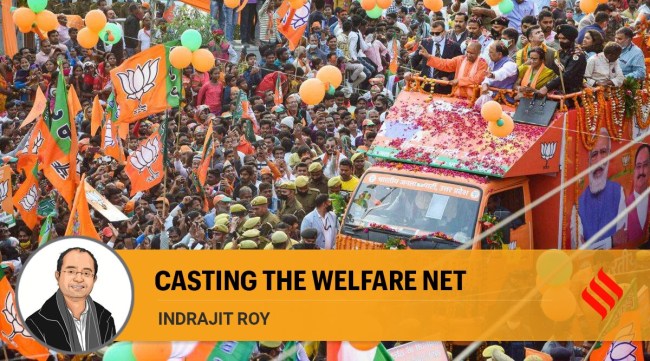Opinion Caste politics does not undermine development
Indrajit Roy writes: UP is a case in point. The state’s progress in overcoming decades, if not centuries, of social exclusion is noteworthy.
 Uttar Pradesh Chief Minister Yogi Adityanath flashes the victory sign during a roadshow for the ongoing UP Assembly elections, in Prayagraj, Friday, Feb. 25, 2022. (PTI Photo)
Uttar Pradesh Chief Minister Yogi Adityanath flashes the victory sign during a roadshow for the ongoing UP Assembly elections, in Prayagraj, Friday, Feb. 25, 2022. (PTI Photo) The ongoing elections in Uttar Pradesh have resurrected claims that caste politics undermines development. The BJP and its supporters in the commentariat argue that caste politics, as allegedly practised by opposition parties such as the BSP and the SP, led to the state’s social and economic backwardness. But NFHS data on human development since 2004 suggests quite the opposite: UP fared as well as, if not better than, its neighbours among the BIMARU states.
Political instability has marred UP since India’s independence in 1947. Although the Congress won decisive majorities in legislative assembly elections held in 1952, 1957 and 1962, no chief minister completed a full-term in the state. After 1967, political instability became even more acute, as power rotated between the many parties that competed for dominance in the state without, however, managing to complete a full term. It was only as late as 2012 that Mayawati became the first chief minister to complete a full term in office.
With an eye on improving life for Dalits, BSP took development very seriously. Its inclusive vision was outlined by the party’s campaign slogan “sarvajan hitay, sarvajan sukhay”, which in English translates into “may everyone benefit, may everyone be prosperous”. Mayawati introduced and implemented a housing scheme for the urban poor. Of the 1,00,000 housing units promised, over 90,000 were constructed by the time her tenure as Chief Minister expired in 2012. She also inaugurated an integrated rural development programme to supply water, electricity and roads in villages with Dalit majorities. Almost 25,000 villages across the state saw improvements within their jurisdictions, and even her worst critics admitted there had been some development compared to previous regimes. Even though the BSP government was unable to introduce structural reforms that would transfer more productive assets to Dalits, its development programmes did reach populations that had hitherto been largely marginalised.
Learning from the experience of neighbouring Bihar, the state government distributed one million bicycles to girls across the state in a bid to improve their access to schooling and general mobility. However, allegations of corruption overshadowed the developmental interventions introduced under her tenure and Mayawati was voted out of power in 2012.
 The new government, formed by the SP, borrowed a page from the BSP’s success at forging social coalitions. It cemented its own Yadav-Muslim coalition that lay at the foundation of the party’s ideology with support from the “upper castes”. Muslim representation in the UP Vidhan Sabha was at the highest since Independence and more closely reflected the community’s population than ever before. Although Akhilesh Yadav scrapped many schemes introduced by Mayawati, he also introduced several new social welfare programmes, including housing subsidies, pensions and unemployment allowances. Furthermore, he distributed 1.5 million laptops to students who completed their secondary and senior secondary education across the state. Perhaps, the highlight of Yadav’s chief ministership was the successful eradication of polio in the state. By 2013, and undoubtedly building on the success of Mayawati’s regime, the state had not reported a single case of polio, a major milestone in global health improvement. The involvement of Muslims in the SP’s social coalition helped to overcome worries from community members that the polio vaccine was aimed against them.
The new government, formed by the SP, borrowed a page from the BSP’s success at forging social coalitions. It cemented its own Yadav-Muslim coalition that lay at the foundation of the party’s ideology with support from the “upper castes”. Muslim representation in the UP Vidhan Sabha was at the highest since Independence and more closely reflected the community’s population than ever before. Although Akhilesh Yadav scrapped many schemes introduced by Mayawati, he also introduced several new social welfare programmes, including housing subsidies, pensions and unemployment allowances. Furthermore, he distributed 1.5 million laptops to students who completed their secondary and senior secondary education across the state. Perhaps, the highlight of Yadav’s chief ministership was the successful eradication of polio in the state. By 2013, and undoubtedly building on the success of Mayawati’s regime, the state had not reported a single case of polio, a major milestone in global health improvement. The involvement of Muslims in the SP’s social coalition helped to overcome worries from community members that the polio vaccine was aimed against them.
The human development outcomes of social coalitions that governed UP between 2007 and 2017 are clearly discernible. Several of these outcomes pertain directly to the effectiveness of the state in delivering services. It is instructive to compare the National Family Health Surveys 3 and 4. NFHS-3 pertains to data collected in 2005-6, just a year before the BSP came to power in UP. NFHS-4 data pertains to the period 2015-6, or a year prior to the SP losing power in UP. Both sets of data offer a useful insight into the changes in human development in the state through the governments of the BSP and SP.
For example, the proportion of children under five years whose births were registered increased from a mere 7 per cent in 2005-6 to over 60 per cent. Among its neighbours, only Bihar has a similar track record. The proportion of births in a public facility similarly increased from 6.6 per cent in 2005-6 to over 44 per cent in 2015-6. Immunisation rates improved. Mortality rates were reduced. A larger proportion of women reported a follow-up visit from a paramedic after the delivery. Indicators of human development pertaining to women’s status registered an improvement. Women’s literacy rates increased to 61 per cent, the highest among the BIMARU states, except Chhattisgarh. The proportion of women with at least 10 years of education also increased, placing UP ahead of the other BIMARU states.
Between 2005 and 2016, UP reduced the incidence of multidimensional poverty by almost 28 percentage points, from 68.8 per cent to 40.8 per cent. Given the size of the state and its enormous social heterogeneity, this was no mean achievement. Not only did UP decrease the incidence of multidimensional poverty during this period, it also reduced its intensity. Alongside Jharkhand, the state reported the lowest intensity of multidimensional poverty among the BIMARU states.
The evidence from Uttar Pradesh is clear. Caste politics, of which the SP and BSP are accused, did not undermine the state’s human development indicators. If anything, the state’s progress in overcoming decades, if not centuries, of social exclusion is noteworthy. It is time our commentariat give credit where it is due.
This column first appeared in the print edition on February 26, 2022 under the title ‘Casting the welfare net’. The writer is senior lecturer, University of York.






